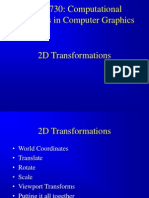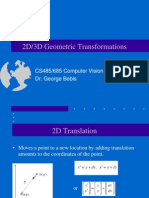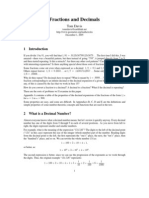2d Transformations
2d Transformations
Uploaded by
hfarrukhnCopyright:
Available Formats
2d Transformations
2d Transformations
Uploaded by
hfarrukhnOriginal Description:
Copyright
Available Formats
Share this document
Did you find this document useful?
Is this content inappropriate?
Copyright:
Available Formats
2d Transformations
2d Transformations
Uploaded by
hfarrukhnCopyright:
Available Formats
2D TRANSFORMATIONS
2D Transformations
What is transformations?
The geometrical changes of an object from a
current state to modified state.
Why the transformations is needed?
To manipulate the initially created object and to
display the modified object without having to
redraw it.
2 ways
Object Transformation
Alter the coordinates descriptions an object
Translation, rotation, scaling etc.
Coordinate system unchanged
Coordinate transformation
Produce a different coordinate system
2D Transformations
Matrix Math
Why do we use matrix?
More convenient organization of data.
More efficient processing
Enable the combination of various
concatenations
Matrix addition and subtraction
a
b
c
d
a c
b d
=
How about it?
Matrix Multiplication
Dot product
Matrix Math
a
b
c d
e f
a b
c d
e f
g h
. =
a.e + b.g a.f + b.h
c.e + d.g c.f + d.h
What about this?
Type of matrix
Matrix Math
1 2 .
1 2
3 1
=
6 6
2
3
.
1 2
3 1
=
tak boleh!!
a b
a
b
Row-vector Column-vector
Is there a difference between possible
representations?
Matrix Math
=
(
(
+
+
df ce
bf ae
(
(
-
(
(
f
e
d c
b a
| |
df be cf ae
+ + = | |
d c
b a
f e
(
(
-
| |
df ce bf ae
+ + = | |
d b
c a
f e
(
(
-
Well use the column-vector representation for a
point.
Which implies that we use pre-multiplication of
the transformation it appears before the point to
be transformed in the equation.
What if we needed to switch to the other
convention?
(
+
+
=
(
-
(
Dy Cx
By Ax
y
x
D C
B A
Matrix Math
Translation
A translation moves all points
in an object along the same
straight-line path to new
positions.
The path is represented by a
vector, called the translation or
shift vector.
We can write the components:
p'
x
= p
x
+ t
x
p'
y
= p
y
+ t
y
or in matrix form:
P' = P + T
t
x
t
y
x
y
x
y
t
x
t
y
= +
(2, 2)
= 6
=4
?
Rotation
A rotation repositions
all points in an object
along a circular path in
the plane centered at
the pivot point.
First, well assume the
pivot is at the origin.
u
P
P
Rotation
Review Trigonometry
=> cos | = x/r , sin |= y/r
x = r. cos |, y = r.sin |
u
|
P(x,y)
x
y
r
x
y
u
P(x, y)
r
=> cos (|+ u) = x/r
x = r. cos (|+ u)
x = r.cos|cosu -r.sin|sinu
x = x.cos u y.sin u
=>sin (|+ u) = y/r
y = r. sin (|+ u)
y = r.cos|sinu + r.sin|cosu
y = x.sin u + y.cos u
Identity of Trigonometry
Rotation
We can write the components:
p'
x
= p
x
cos u p
y
sin u
p'
y
= p
x
sin u + p
y
cos u
or in matrix form:
P' = R P
u can be clockwise (-ve) or
counterclockwise (+ve as our
example).
Rotation matrix
u
P(x,y)
|
x
y
r
x
y
u
P(x, y)
(
=
u u
u u
cos sin
sin cos
R
Example
Find the transformed point, P, caused by
rotating P= (5, 1) about the origin through an
angle of 90.
Rotation
(
+
=
(
-
(
u u
u u
u u
u u
cos sin
sin cos
cos sin
sin cos
y x
y x
y
x
(
+
=
90 cos 1 90 sin 5
90 sin 1 90 cos 5
(
+
=
0 1 1 5
1 1 0 5
(
=
5
1
Scaling
Scaling changes the size of an
object and involves two scale
factors, S
x
and S
y
for the x-
and y- coordinates
respectively.
Scales are about the origin.
We can write the components:
p'
x
= s
x
p
x
p'
y
= s
y
p
y
or in matrix form:
P' = S P
Scale matrix as:
(
=
y
x
s
s
S
0
0
P
P
Scaling
If the scale factors are in between 0
and 1 the points will be moved
closer to the origin the object
will be smaller.
P(2, 5)
P
Example :
P(2, 5), Sx = 0.5, Sy = 0.5
Find P ?
Scaling
If the scale factors are in between 0
and 1 the points will be moved
closer to the origin the object
will be smaller.
P(2, 5)
P
Example :
P(2, 5), Sx = 0.5, Sy = 0.5
Find P ?
If the scale factors are larger than 1
the points will be moved away
from the origin the object will be
larger.
P
Example :
P(2, 5), Sx = 2, Sy = 2
Find P ?
Scaling
If the scale factors are the same,
S
x
= S
y
uniform scaling
Only change in size (as previous
example)
P(1, 2)
P
If S
x
= S
y
differential scaling.
Change in size and shape
Example : square rectangle
P(1, 3), S
x
= 2, S
y
= 5 , P ?
What does scaling by 1 do?
What is that matrix called?
What does scaling by a negative value do?
Combining transformations
We have a general transformation of a point:
P' = M P + A
When we scale or rotate, we set M, and A is the additive
identity.
When we translate, we set A, and M is the multiplicative
identity.
To combine multiple transformations, we must explicitly
compute each transformed point.
Itd be nicer if we could use the same matrix operation all the
time. But wed have to combine multiplication and addition
into a single operation.
Homogenous Coordinates
Lets move our problem into 3D.
Let point (x, y) in 2D be represented by point (x, y, 1) in the
new space.
Scaling our new point by any value a puts us somewhere along
a particular line: (ax, ay, a).
A point in 2D can be represented in many ways in the new
space.
(2, 4) ---------- (8, 16, 4) or (6, 12, 3) or (2, 4, 1) or etc.
y y
x
x
w
Homogenous Coordinates
We can always map back to the original 2D point by dividing
by the last coordinate
(15, 6, 3) --- (5, 2).
(60, 40, 10) - ?.
Why do we use 1 for the last coordinate?
The fact that all the points along each line can be mapped
back to the same point in 2D gives this coordinate system its
name homogeneous coordinates.
Matrix Representation
Point in column-vector:
Our point now has three coordinates. So our matrix is
needs to be 3x3.
Translation
x
y
1
(
(
(
-
(
(
(
=
(
(
(
'
'
1 1 0 0
1 0
0 1
1
y
x
t
t
y
x
y
x
Rotation
Scaling
Matrix Representation
(
(
(
-
(
(
(
=
(
(
(
'
'
1 1 0 0
0 cos sin
0 sin cos
1
y
x
y
x
u u
u u
(
(
(
-
(
(
(
=
(
(
(
'
'
1 1 0 0
0 0
0 0
1
y
x
s
s
y
x
y
x
Composite Transformation
We can represent any sequence of transformations
as a single matrix.
No special cases when transforming a point matrix
vector.
Composite transformations matrix matrix.
Composite transformations:
Rotate about an arbitrary point translate, rotate,
translate
Scale about an arbitrary point translate, scale,
translate
Change coordinate systems translate, rotate, scale
Does the order of operations matter?
Composition Properties
Is matrix multiplication associative?
(A.B).C = A.(B.C)
(
(
+ + + + + +
+ + + + + +
=
(
(
-
(
(
+ +
+ +
=
dhl cfl dgj cej dhk cfk dgi cei
bhl afl bgj aej bhk afk bgi aei
l k
j i
dh cf dg ce
bh af bg ae
(
(
-
|
|
.
|
\
|
(
(
-
(
(
l k
j i
h g
f e
d c
b a
(
(
+ + + + + +
+ + + + + +
=
(
(
+ +
+ +
-
(
(
=
dhl dgj cfl cej dhk dgi cfk cei
bhl bgj afl aej bhk bgi afk aei
hl gj hk gi
fl ej fk ei
d c
b a
|
|
.
|
\
|
(
(
-
(
(
-
(
(
l k
j i
h g
f e
d c
b a
?
Is matrix multiplication commutative?
A . B = B . A
Composition Properties
?
(
+ +
+ +
=
(
-
(
dh cf dg ce
bh af bg ae
h g
f e
d c
b a
(
+ +
+ +
=
(
-
(
hd gb hc ga
fd eb fc ea
d c
b a
h g
f e
Order of operations
So, it does matter. Lets look at an example:
1. Translate
2. Rotate
1. Rotate
2. Translate
Composite Transformation Matrix
Arrange the transformation matrices in order from right to left.
General Pivot- Point Rotation
Operation :-
1. Translate (pivot point is moved to origin)
2. Rotate about origin
3. Translate (pivot point is returned to original position)
T(pivot) R(u) T(pivot)
1 0 -t
x
0 1 -t
y
0 0 1
cosu -sinu 0
sinu cosu 0
0 0 1
1 0 t
x
0 1 t
y
0 0 1
. .
cosu -sinu -t
x
cosu+ t
y
sinu + t
x
sinu cosu -t
x
sinu - t
y
cosu + t
y
0 0 1
cosu -sinu -t
x
cosu+ t
y
sinu
sinu cosu -t
x
sinu - t
y
cosu
0 0 1
1 0 t
x
0 1 t
y
0 0 1
.
Example
Perform 60 rotation of a point P(2, 5) about a
pivot point (1,2). Find P?
Composite Transformation Matrix
cosu -sinu -t
x
cosu+ t
y
sinu + t
x
sinu cosu -t
x
sinu - t
y
cosu + t
y
0 0 1
x
y
1
.
0.5 -0.866 -1.0.5 + 2.0.866 + 1
0.866 0.5 -1.0.866- 2.0.5 + 2
0 0 1
2
5
1
.
0.5 - 0.866 2.232
0.866 0.5 0.134
0 0 1
2
5
1
.
=
-1.098
4.366
1
P = (-1, 4)
Sin 60 = 0.8660
Kos 60 = 1/2
Without using composite
homogenus matrix
Example
Perform 90 rotation of a point P(5, 1) about a pivot
point (2, 2). Find P?
1. Translate pivot point ke asalan ( tx = -2, ty = -2)
Titik P(5, 1 ) P (3, -1)
2. Rotate P = 90 degree
P(3, -1) -- > kos 90 -sin 90 3 = 0 -1 3 = 1
sin 90 kos 90 -1 1 0 -1 3
3. Translate back ke pivot point (tx = 2 , ty = 2)
titik (1, 3 ) titik akhir (3, 5)
Composite Transformation Matrix
General Fixed-Point Scaling
Operation :-
1. Translate (fixed point is moved to origin)
2. Scale with respect to origin
3. Translate (fixed point is returned to original position)
T(fixed) S(scale) T(fixed)
Find the matrix that represents scaling of an
object with respect to any fixed point?
Given P(6, 8) , Sx = 2, Sy = 3 and fixed point
(2, 2). Use that matrix to find P?
Answer
1 0 -t
x
0 1 -t
y
0 0 1
Sx 0 0
0 Sy 0
0 0 1
1 0 t
x
0 1 t
y
0 0 1
. .
Sx 0 -t
x
Sx
0 Sy -t
y
Sy
0 0 1
1 0 t
x
0 1 t
y
0 0 1 .
=
x =6, y = 8, Sx = 2, Sy = 3, t
x
=2, t
y
= 2
Sx 0 -t
x
Sx + t
x
0 Sy -t
y
Sy + t
y
0 0 1
2 0 -2(
2) + 2
0 3 -2(3) + 2
0 0 1
.
6
8
1
=
10
20
1
Composite Transformation Matrix
General Scaling Direction
Operation :-
1. Rotate (scaling direction align with the coordinate axes)
2. Scale with respect to origin
3. Rotate (scaling direction is returned to original position)
R(u) S(scale) R(u)
Find the composite transformation matrix
by yourself !!
latihan
Dapatkan titik akhir bagi P(5, 8) jika titik
tersebut diputarkan sebanyak 90 darjah,
kemudian ditranslate sebanyak (-6, 9) dan
akhirnya diskala dengan faktor skala (2,
0.5).
cosu -sinu 0
sinu cosu 0
0 0 1
Sx 0 0
0 Sy 0
0 0 1
1 0 t
x
0 1 t
y
0 0 1
. .
S . T . R
cosu -sinu t
x
sinu cosu t
y
0 0 1
Sx 0 0
0 Sy 0
0 0 1
.
Sxcosu Sx(-sinu) Sx t
x
Sy sinu Sy cosu Sy t
y
0 0 1
Other transformations
Reflection:
x-axis y-axis
(
(
(
1 0 0
0 1 0
0 0 1
(
(
(
1 0 0
0 1 0
0 0 1
Other transformations
Reflection:
origin line x=y
(
(
(
1 0 0
0 1 0
0 0 1
(
(
(
1 0 0
0 0 1
0 1 0
Other transformations
Shear:
x-direction y-direction
(
(
(
1 0 0
0 1 0
0 1
x
sh
(
(
(
1 0 0
0 1
0 0 1
y
sh
Coordinate System Transformations
We often need to transform points from one coordinate system to
another:
1. We might model an object in non-Cartesian space (polar)
2. Objects may be described in their own local system
3. Other reasons: textures, display, etc
You might also like
- 2D Coordinate Transformations Nick Battjes, Senior Student: Spatial Data Without Coordinates Control PointsDocument33 pages2D Coordinate Transformations Nick Battjes, Senior Student: Spatial Data Without Coordinates Control PointsRamo Kiss100% (2)
- 2d TransformationsDocument38 pages2d TransformationsPoonam GholapNo ratings yet
- 2D Geometric TransformationsDocument21 pages2D Geometric TransformationsRajaRaman.GNo ratings yet
- CG 2d TransDocument41 pagesCG 2d TranssanchitahiwraleNo ratings yet
- 2D TransformationsDocument15 pages2D TransformationsRam AcNo ratings yet
- Opengl Primitives: CSE 320 Graphics ProgrammingDocument32 pagesOpengl Primitives: CSE 320 Graphics ProgrammingIsaac Joel RajNo ratings yet
- 2D TransformationDocument31 pages2D Transformationmohanmech2006886No ratings yet
- 2D TransformationsDocument56 pages2D Transformationsguptatulsi31No ratings yet
- CG 3Document48 pagesCG 3khadakesushant114No ratings yet
- 2D Transformations - Basics of Viewing 1683152046587Document63 pages2D Transformations - Basics of Viewing 1683152046587MADHUSUDAN KUMARNo ratings yet
- Unit IDocument30 pagesUnit IRupeshNo ratings yet
- 2d TransformationsDocument47 pages2d TransformationsDevesh SharmaNo ratings yet
- 2D Transformation 2D Transformation 2D Transformation 2D TransformationDocument14 pages2D Transformation 2D Transformation 2D Transformation 2D TransformationAnkit AgarwalNo ratings yet
- 2DTRANSFORMATIONSDocument51 pages2DTRANSFORMATIONSgulati.paranjayNo ratings yet
- CS 6504-Computer GraphicsDocument54 pagesCS 6504-Computer GraphicsKARTHIBAN RAYARSAMYNo ratings yet
- Unit - III 2D-TransformationDocument48 pagesUnit - III 2D-Transformationpankajchandre30No ratings yet
- Section - III: Transformations in 2-D in 2-DDocument33 pagesSection - III: Transformations in 2-D in 2-DImblnrNo ratings yet
- Introduction To Computer Graphics CS 445 / 645: TransformationsDocument52 pagesIntroduction To Computer Graphics CS 445 / 645: TransformationsRehan HalaiNo ratings yet
- Computer Graphics and Animation - 09 TransformationsDocument35 pagesComputer Graphics and Animation - 09 TransformationsmisteryfollowNo ratings yet
- CAP4730: Computational Structures in Computer GraphicsDocument47 pagesCAP4730: Computational Structures in Computer GraphicsAshik A NezzilianzNo ratings yet
- Composite TransformationDocument24 pagesComposite TransformationTerimNo ratings yet
- Homogeneous CoordinatesDocument14 pagesHomogeneous CoordinatesAjad AliNo ratings yet
- 2 D TransformationDocument43 pages2 D TransformationNilesh RanaNo ratings yet
- 2D Geometrical TransfDocument13 pages2D Geometrical TransfkomalpillaNo ratings yet
- 2 2dtransformsDocument28 pages2 2dtransformsAman SinhaNo ratings yet
- MAE 152 Computer Graphics For Scientists and Engineers: Splines and Bezier CurvesDocument76 pagesMAE 152 Computer Graphics For Scientists and Engineers: Splines and Bezier CurvesPrateek ChakrabortyNo ratings yet
- 3.2d TransformationDocument94 pages3.2d TransformationPrachit YelamkarNo ratings yet
- Computer Graphic Chapter 2Document45 pagesComputer Graphic Chapter 2Rahul KarnNo ratings yet
- Cgsem 4 PPT 3Document24 pagesCgsem 4 PPT 3Subash RajeshNo ratings yet
- 2-D TransDocument26 pages2-D TransAkanksha GuptaNo ratings yet
- Geometric TransformationsDocument40 pagesGeometric TransformationssfundsNo ratings yet
- Cim 23.6Document81 pagesCim 23.6RajeshKumarNo ratings yet
- Intro To TransformationsDocument31 pagesIntro To Transformationsachintya0105No ratings yet
- Transformation - 2DDocument93 pagesTransformation - 2DKashika MehtaNo ratings yet
- APznzaY4YQpzR3bjawlbrJiL-hQG9CJYt8s9zOOjax4TEWza8xYQfW7F9hoDsKDkqfF9tpS4GZkBjNxpHsQkJ1YXCTvayegReAkDildvLz...ZBu-n9OnHZOsl3DFQeUyGzdi6pTnRMMExf_0QxoEfqKdxgzM3GVQCBjHN3gCQwrLO2f3flPXVsmlXML3a6GwG1cnKTrPHQX7eMevw0S3f5sPIQQe98KasLY-U=Document49 pagesAPznzaY4YQpzR3bjawlbrJiL-hQG9CJYt8s9zOOjax4TEWza8xYQfW7F9hoDsKDkqfF9tpS4GZkBjNxpHsQkJ1YXCTvayegReAkDildvLz...ZBu-n9OnHZOsl3DFQeUyGzdi6pTnRMMExf_0QxoEfqKdxgzM3GVQCBjHN3gCQwrLO2f3flPXVsmlXML3a6GwG1cnKTrPHQX7eMevw0S3f5sPIQQe98KasLY-U=sidghogare51No ratings yet
- CGR U3T1 Presentation9Document20 pagesCGR U3T1 Presentation9Kaiwalya MatreNo ratings yet
- CAP4730: Computational Structures in Computer GraphicsDocument47 pagesCAP4730: Computational Structures in Computer GraphicsSahib SodhiNo ratings yet
- CAP4730: Computational Structures in Computer GraphicsDocument47 pagesCAP4730: Computational Structures in Computer GraphicsAdityasinh DesaiNo ratings yet
- CS8092 Computer Graphics and Multimedia UNIT II-Two Dimensional Graphics 2.1 Two Dimensional Geometric TransformationsDocument24 pagesCS8092 Computer Graphics and Multimedia UNIT II-Two Dimensional Graphics 2.1 Two Dimensional Geometric TransformationsShirley AndrinaNo ratings yet
- Computer Graphics 3: 2D Transformations: Downloaded FromDocument46 pagesComputer Graphics 3: 2D Transformations: Downloaded Frombharat_csm11No ratings yet
- 9 - ParameterizationDocument48 pages9 - Parameterizationandriusjaya787No ratings yet
- Modeling Transformations: 2D Transformations 3D Transformations Opengl TransformationDocument69 pagesModeling Transformations: 2D Transformations 3D Transformations Opengl TransformationImran HayderNo ratings yet
- Kinematics ConceptsDocument41 pagesKinematics ConceptsHannan ShahNo ratings yet
- Geometric TransformationDocument8 pagesGeometric TransformationDaljeet SinghNo ratings yet
- 2D TransformsDocument33 pages2D TransformssyriluitNo ratings yet
- CG Unit 2Document113 pagesCG Unit 2kariaharsh5No ratings yet
- CST 304 - Computer Graphics: 2D TransformationsDocument34 pagesCST 304 - Computer Graphics: 2D TransformationsMalu VavuNo ratings yet
- Two Dimentional Transformation in Computer GraphicsDocument25 pagesTwo Dimentional Transformation in Computer GraphicsBokhtiar Mehedy FarsimNo ratings yet
- CG Chapter 5Document15 pagesCG Chapter 5rajmaisuria111No ratings yet
- L5 2dtransDocument21 pagesL5 2dtransMidhun ChakravarthyNo ratings yet
- CAP4730: Computational Structures in Computer GraphicsDocument33 pagesCAP4730: Computational Structures in Computer GraphicsFarid Ali MousaNo ratings yet
- 2 - D Transformations: X' X + TX Y' y + TyDocument7 pages2 - D Transformations: X' X + TX Y' y + TyAnonymous 4hnxnYNo ratings yet
- COMPUTER GRAPHICS 2D TransformationsDocument47 pagesCOMPUTER GRAPHICS 2D TransformationsNagireddy Saicharan ReddyNo ratings yet
- 2D Geometrical Transformations: Foley & Van Dam, Chapter 5Document34 pages2D Geometrical Transformations: Foley & Van Dam, Chapter 5Vincent VetterNo ratings yet
- MatrixDocument60 pagesMatrixsadhanamca1No ratings yet
- Transformation of Axes (Geometry) Mathematics Question BankFrom EverandTransformation of Axes (Geometry) Mathematics Question BankRating: 3 out of 5 stars3/5 (1)
- A-level Maths Revision: Cheeky Revision ShortcutsFrom EverandA-level Maths Revision: Cheeky Revision ShortcutsRating: 3.5 out of 5 stars3.5/5 (8)
- Trigonometric Ratios to Transformations (Trigonometry) Mathematics E-Book For Public ExamsFrom EverandTrigonometric Ratios to Transformations (Trigonometry) Mathematics E-Book For Public ExamsRating: 5 out of 5 stars5/5 (1)
- Inverse Trigonometric Functions (Trigonometry) Mathematics Question BankFrom EverandInverse Trigonometric Functions (Trigonometry) Mathematics Question BankNo ratings yet
- Service Measurement IndexDocument8 pagesService Measurement IndexhfarrukhnNo ratings yet
- Quantitative TechniquesDocument264 pagesQuantitative TechniqueshfarrukhnNo ratings yet
- Anoka - Hennepin - Probability - and - Statistics-4 2013 NEW PDFDocument357 pagesAnoka - Hennepin - Probability - and - Statistics-4 2013 NEW PDFhfarrukhnNo ratings yet
- Ijisa V7 N12 8Document8 pagesIjisa V7 N12 8hfarrukhnNo ratings yet
- NHSN OverviewDocument5 pagesNHSN OverviewhfarrukhnNo ratings yet
- Understanding The Impact of Multi-Core Architecture in Cluster Computing: A Case Study With Intel Dual-Core SystemDocument8 pagesUnderstanding The Impact of Multi-Core Architecture in Cluster Computing: A Case Study With Intel Dual-Core SystemhfarrukhnNo ratings yet
- Advanced - Calculus.for - Applications Hildebrand 1962Document657 pagesAdvanced - Calculus.for - Applications Hildebrand 1962Conan100% (4)
- AE306 Digital Signal ProcessingDocument2 pagesAE306 Digital Signal ProcessingTINANo ratings yet
- Class X English Maths Chapter01Document15 pagesClass X English Maths Chapter01Deena DayalanNo ratings yet
- Inverse Trig FunctionsDocument12 pagesInverse Trig FunctionsZazliana IzattiNo ratings yet
- Continuity 1 JSGCDocument11 pagesContinuity 1 JSGCJotinderpal SinghNo ratings yet
- Meaning of Rounding OffDocument3 pagesMeaning of Rounding OffChris Ily MappahNo ratings yet
- Finite Automata and Formal Languages: Testing Equivalence of Regular LanguagesDocument6 pagesFinite Automata and Formal Languages: Testing Equivalence of Regular LanguagesSanya ChawlaNo ratings yet
- Composition of FunctionsDocument4 pagesComposition of Functionscircleteam123No ratings yet
- Xii Matrices and Determinants Work Sheet 2018Document5 pagesXii Matrices and Determinants Work Sheet 2018180478No ratings yet
- Fractions and Decimals: Tom DavisDocument15 pagesFractions and Decimals: Tom Davisparisdakar40No ratings yet
- Mat127b HW 0201Document3 pagesMat127b HW 0201Jean PierreNo ratings yet
- Prmo SolutionDocument17 pagesPrmo SolutionBilly BlattNo ratings yet
- Chap2 FullDocument18 pagesChap2 FullNuo XuNo ratings yet
- A Novel Approach To The Fast Computation of Zernike Moments: Sun-Kyoo Hwang, Whoi-Yul KimDocument12 pagesA Novel Approach To The Fast Computation of Zernike Moments: Sun-Kyoo Hwang, Whoi-Yul KimSaasiNo ratings yet
- 326929266Document4 pages326929266Mahmood AhmadiNo ratings yet
- Nature of Mathematics Set TheoryDocument40 pagesNature of Mathematics Set TheoryEduard Noe EscorpisoNo ratings yet
- 18 Further Differentiation MethodsDocument23 pages18 Further Differentiation MethodsjackNo ratings yet
- XI Maths SETS Assignments HssliveDocument1 pageXI Maths SETS Assignments HssliveSafwan SafuNo ratings yet
- Problem Score Problem Score Problem Score 1 (15 PTS) 4 (12 PTS) 7 (11 PTS) 2 (18 PTS) 5 (12 PTS) 8 (15 PTS) 3 (12 PTS) 6 (12 PTS) TotalDocument10 pagesProblem Score Problem Score Problem Score 1 (15 PTS) 4 (12 PTS) 7 (11 PTS) 2 (18 PTS) 5 (12 PTS) 8 (15 PTS) 3 (12 PTS) 6 (12 PTS) Totalrcherry calaorNo ratings yet
- Four Basic ConceptsDocument12 pagesFour Basic ConceptsMaria Trisha Ann Amparo75% (8)
- Summative Test q1 Gen MathDocument2 pagesSummative Test q1 Gen MathLhinever GilhangNo ratings yet
- m2 Nat SPWBDocument104 pagesm2 Nat SPWBOksanaBilenka100% (1)
- Nabptex 2015Document3 pagesNabptex 2015tignandolatif7No ratings yet
- Curriculum Map Math 10Document10 pagesCurriculum Map Math 10Richimon LicerioNo ratings yet
- College of Teacher Education Integrated Laboratory School High School Department Western Mindanao State University Grade 8 - MathematicsDocument8 pagesCollege of Teacher Education Integrated Laboratory School High School Department Western Mindanao State University Grade 8 - MathematicsAlwyn SacandalNo ratings yet
- 01 As Pure Mathematics Practice Paper ADocument6 pages01 As Pure Mathematics Practice Paper AFrankNo ratings yet
- 19th Century MathematicsDocument7 pages19th Century MathematicsMacaguiwa, C-j RoldanNo ratings yet
- Subspace Identification of Pure Stochastic SystemsDocument6 pagesSubspace Identification of Pure Stochastic SystemsGuille Ciprian NoaNo ratings yet
- Laplace Transform Systems of deDocument35 pagesLaplace Transform Systems of deANDRES ESTEBAN NOBOA VILLACISNo ratings yet






























































































